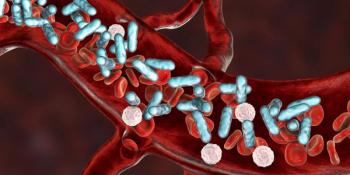
FOLFIRI Plus ICIs Display Anti-Tumor Activity in Gastric/GEJ Cancer
Using FOLFIRI as a doublet with durvalumab or a triplet with durvalumab and tremelimumab yielded positive safety in gastric/GEJ cancers.
The use of leucovorin, fluorouracil, and irinotecan (FOLFIRI) plus durvalumab (Imfinzi) or tremelimumab-actl (Imjudo) as second-line treatment showed anti-tumor activity for subgroups of patients with advanced gastric/gastroesophageal (GEJ) cancer, according to results from the phase 2 PRODIGE 59-FFCD 1707-DURIGAST trial (NCT03959293).
In the FOLFIRI plus durvalumab arm, the 4-month progression-free survival (PFS) was 44.7% (90% CI, 32.3%-57.7%) vs 55.6% (90% CI, 42.3%-68.3%) in the FOLFIRI plus durvalumab and tremelimumab arm. Between both arms, the median PFS was 3.8 months (95% CI, 3.0-7.4) and 5.4 months (95% CI, 2.9-6.4). The 12-month PFS in the doublet arm was 11.0% (95% CI, 4.0%-21.9%) vs 17.8% (95% CI, 8.3%-30.1%) in the triplet arm.
The primary end point of the percentage of patients alive without progression at 4 months was not met.
“PRODIGE 59-FFCD 1707-DURIGAST showed that FOLFIRI combined with immune checkpoint inhibitors [ICIs] has an acceptable safety profile and provides significant antitumor activity in a subgroup of about 20% of patients, even if the primary end point was not met,” David Tougeron, MD, PhD, a digestive oncologist at Poitiers University Hospital in France, and coauthors wrote regarding the study. “This regimen thus deserves evaluation in a randomized phase 3 clinical trial comparing FOLFIRI combined with ICIs vs FOLFIRI alone in a selected subgroup of patients with favorable biomarkers that remain to be identified.”
A total of 96 patients across 37 centers in France were selected, and 92 received 1 or more doses of treatment. The median age was 59.7 years old, 69.6% were male, and 66.3% had an ECOG performance status of 1. GEJ tumors were observed in 53.3% of patients, and 46.7% had stomach tumors. Additionally, 60.9% of patients were treated with doublet first-line chemotherapy, and 68.8% had disease control at 3 or more months.
Leucovorin was given at 400 mg/m2, a 5-fluorouracil bolus at 400 mg/m2, continuous 5-fluorouracil at 2400 mg/m2, and irinotecan at 180 mg/m2 every 2 weeks. Durvalumab was given at 1500 mg every 4 weeks, and tremelimumab was given at 75 mg every 4 weeks.
Patients most often had metastases of the liver (40.2%), lymph nodes (39.1%), and peritoneum (35.9%). Microsatellite instability was more commonly proficient disease (92.4%) than deficient (4.5%).
The median follow-up was 20.3 months (95% CI, 18.0-22.0) in the doublet arm and 23.2 months (95% CI, 17.9-23.5) in the triplet arm. Of note, 44 patients in the durvalumab arm and 39 in the durvalumab plus tremelimumab arm discontinued treatment. Between arms, the median duration of treatment was 3.8 months vs 5.5 months.
In the FOLFIRI plus durvalumab arm, the overall response rate was 34.7%, and in the FOLFIRI plus durvalumab and tremelimumab arm, it was 37.7%. The disease control rate was 67.4% vs 68.9%. The median duration of response in the doublet arm was 6.1 months and 10.0 months in the triplet arm.
In the doublet arm, 76.6% of patients died vs 77.8% in the triplet arm. Between arms, the median overall survival (OS) was 13.2 months (95% CI, 6.6-15.6) vs 9.5 months (95% CI, 7.1-11.3). At 12 months, OS was 52.4% (95% CI, 37.2%-65.6%) vs 35.6% (95% CI, 22.0%-49.3%).
The median PFS for those with a PD-L1 combined positive score (CPS) of 5 or higher was 3.6 months (95% CI, 1.9-5.9), and for those with a CPS of lower than 5, it was 5.4 months (95% CI, 3.6-7.4). The median PFS for those with a CPS of 5 or higher was 1.9 months (95% CI, 1.7-not applicable [NA]) in the doublet arm and 5.0 months (95% CI, 1.9-7.4) in the triplet arm. The 12-month PFS was 0% vs 21.4% (95% CI, 5.2%-44.8%), respectively, between the doublet and triplet arms.
At least 1 treatment-related adverse effect (TRAE) was experienced in 93.5% of patients in the doublet arm and 93.5% in the triplet arm. Grade 3/4 TRAEs occurred in 47.8% of patients in both arms and included asthenia (17.4% vs 28.3%), neutropenia (15.2% vs 23.9%), anemia (10.9% vs 6.5%), diarrhea (2.2% vs 10.9%), and vomiting (6.5% vs 6.5%).
A total of 8.7% of patients had grade 3/4 immune-related AEs in the doublet arm compared with 10.9% in the triplet arm, which included diarrhea and colitis (5.4%). Of note, no deaths were considered related to treatment.
Between both arms, treatment was stopped definitively due to TRAEs (8.7% vs 6.5%). In each arm, 1 patient stopped durvalumab because of immune-related AEs, and 2 in the triplet arm stopped tremelimumab because of immune-related AEs.
The median time until a deterioration in quality of life was 7.4 months (95% CI, 4.2-12.0) in the doublet arm and 8.3 months (95% CI, 4.7-14.8) in the triplet arm.
Reference
Tougeron D, Dahan L, Evesque L, et al. FOLFIRI plus durvalumab with or without tremelimumab in second-line treatment of advanced gastric or gastroesophageal junction adenocarcinoma: the PRODIGE 59-FFCD 1707-DURIGAST randomized clinical trial. JAMA Oncol. Published online April 4, 2024. doi:10.1001/jamaoncol.2024.0207
Newsletter
Stay up to date on recent advances in the multidisciplinary approach to cancer.

















































































